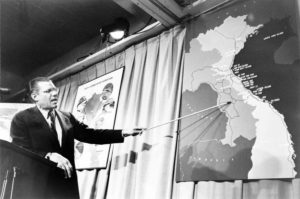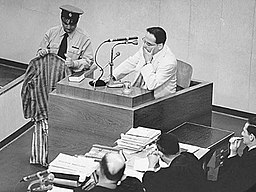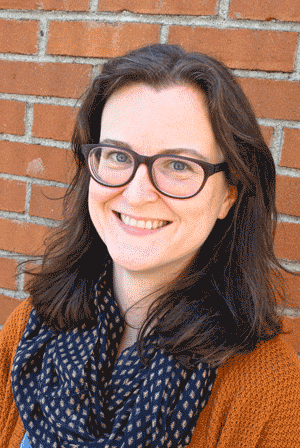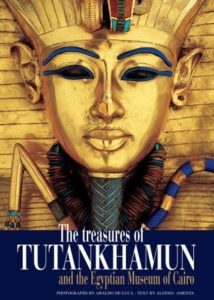RAND Narratology
by Kent Puckett

Robert S. McNamara. US News & aNd World Report, 1965
This penetrating essay by Representations‘ own Kent Puckett looks at the unlikely historical and aesthetic overlap between narrative theory and strategic defense thinking in the middle part of the twentieth century. Taking in the many writings and frankly odd intellectual styles of nuclear war planners working at the RAND Corporation, the essay examines the unexpected play between the material facts of intellectual history, the obscure but nonetheless real force of narrative desire, and the unthinkable costs of nuclear war.
The essay begins:
In late 1947, John Williams, recruiting for what was then called Project RAND, sent the Hungarian mathematician John von Neumann a letter offering him two hundred dollars a month in exchange for just a little slice of his time:
In practice I would hope that members of the Project with problems in your line (i.e., the wide world) could discuss them with you, by mail and in person. We would send you all working papers and reports of RAND which we think would interest you, expecting you to react (with frown, hint, or suggestion) when you had a reaction. In this phase, the only part of your thinking time we’d like to bid for systematically is that which you spend shaving: we’d like you to pass on to us any ideas that come to you while so engaged.
Von Neumann—who, with Oskar Morgenstern, wrote 1944’s Theory of Games and Economic Behavior, more or less inventing game theory—would go on to work, and not only while shaving, with RAND on a number of its key Cold War projects, especially helping to refine its early application of game-theoretical models to the problems of nuclear war planning and strategic deterrence.
The story is characteristic of the early days at RAND. First, it is one of many RAND anecdotes about von Neumann that highlight the fact and local value of his uncanny and apparently unlimited brilliance; it is thus proof not only of von Neumann’s reputation for intellectual virtuosity but also of the peculiar emphasis that RAND placed on brains, on an intelligence that was rapid, ruthless, burning bright. A colleague at the Princeton Institute for Advanced Study reported that “Johnny’s mind . . . was lightning quick—stunningly fast. If you gave him a problem he either solved it right away or not at all.” More than just a prerequisite for the analysis and modeling to which RAND was committed, excessive, throwaway, for-its-own-sake brilliance was, as we will see, an important and, indeed, constitutive aspect of the early RAND style. Second, Williams’s note suggests a kind of desperate whimsy that seemed almost de rigueur at RAND. Hard drinks, good music and good food, modernist interior design, Ping-Pong, dirty jokes, cool jazz, fraternity pranks, and sci-fi: accounts of the early days at RAND make it look as much like a David Lodge novel or an episode of Mad Men as the well-funded think tank that in fact it was. The RAND milieu, writes one critic, “offered the exhilarating emotional palette of a certain type of boy’s world: a virtuous people menaced by evil zealots, the fate of millions concentrated in the hands of a daring few.” “Life at RAND,” writes another, “was a boy’s conception of what a man’s life should be, down to the fragrant pipe tobacco, fast cars, and clubby exclusivity.” Its humor was a boy’s humor, too. Like Williams, von Neumann was “an inveterate jokester”: “Merrill Flood recalls the time that Einstein was supposed to go to New York and von Neumann offered to drive him to the Princeton train station. Von Neumann purposely put Einstein on a train going in the wrong direction.”
A similarly affected eccentricity appears in Williams’s own popular introduction to game theory, The Compleat Strategyst: Being a Primer on the Theory of Games of Strategy (1954). In addition to its cod-Elizabethan title, its leaden gags, and its water-cooler misogyny, Williams’s book was illustrated in an urbane, by-the-way style reminiscent of the New Yorker. Where, however, contemporary comics by Carl Rose, Jules Feiffer, and Herbert “Herblock” Block displayed real wit about midcentury life and things directly relevant to RAND, Charles Satterfield’s illustrations feel unmotivated and, predictably, a little distasteful. One image of a besmocked painter pausing fussily before applying yet another color to a globe wouldn’t be all that funny in any case, but it seems especially ham-fisted appearing as it does in a RAND publication introducing ideas that backed American policies of containment, strategic deterrence, second-strike capacity, and, in time, proxy war in Southeast Asia and elsewhere.
What’s more, Satterfield’s image and Williams’s text rely on a more general and long-standing relation between war and games that connects the abstract and deadly serious modeling at RAND with a longer if equally fraught history of Kriegsspiel, with, that is, the idea of war as not only a terrible necessity but also an almost aesthetic activity that—like painting, mixing drinks, or telling jokes—is said to give special pleasure when done all for its own sake. Indeed, the offer to pay von Neumann for his nearly idle shaving thoughts, for his extra ideas, for time that would otherwise go to waste, for work that was valuable precisely and paradoxically because it bordered on waste, is evidence of the prodigal ethos of the early days of RAND, an appreciation for the beau geste that could seem to run against the grain of the group’s clean-cut, clinical, avowedly pragmatic, and broadly amoral work on military strategy at an especially high-stakes moment in American and world history. What is most interesting to me is what this all reveals about the generative relation between, on the one hand, RAND’s “hard-headed” realism and, on the other, the elegant, seductive, and oddly excessive qualities, first, of game theory, which was not invented but rather cultivated at RAND, and, after game theory had run out of steam, of systems analysis.
Elegant, excessive, and, as I will argue, strikingly if also—and this is important—minimally narrative. Take, for example, the prisoner’s dilemma, the most famous of game theory’s many models, which was developed at RAND by Merrill Flood and Melvin Dresher in 1950 and subsequently filled out and crucially named by Albert Tucker. Game theory is, roughly, the use of quantitative models to account for or to predict the cooperative or competitive behavior of rational actors within defined states of conflict, and the prisoner’s dilemma is a two-person game that imagines two prisoners who have together committed a crime and must choose separately under interrogation either to remain mum or to confess and thus to incriminate the other. If A and B both speak, both spend two years in prison; if either only A or only B speaks, the one who speaks will go free and the other will spend three years in prison; if neither A nor B speaks, both will spend only a single year in prison. Although the prisoner’s dilemma is an abstract and, in that sense, apparently timeless conceptual construct, it is also a little story, a “stock narrative,” a concrete example that motivates abstraction in terms that recall the bare but nonetheless real narrativity of the folktale: it has characters, a conflict, a setting, and something like a beginning, middle, and end. What’s more, the story of the story, the story of the dilemma’s itinerant passage from RAND through Tucker and then out into the wider world might—again, just barely—mirror the trajectory of the traditional folktale: “Not published as such until years after its invention, the prisoner’s dilemma spread through the scientific community of the 1950s by oral transmission that would satisfy the folklorist’s definition of a dilemma tale.” If the dilemma’s utility is a result of its capacity to quantify conflict, its considerable and enduring appeal is due, at least in part, to what was only apparently inessential or extra to it: a minimally developed narrative set-up that motivated abstraction in the familiar terms of temporally distinct and yet causally related events: crime, confession, punishment. Just as structuralist and formalist thinkers were working in the 1950s and 1960s to theorize literariness as an objective, more or less present, and semi-autonomous aspect of some kinds of language, the quantitative realists at RAND demonstrated—and not only in their early work on game theory—a similar commitment to the ostensible autonomy of rules, systems, and, as I’ll argue, to narrative understood as independent of whatever it might in fact narrate.
It is important, given a tendency simply to equate RAND nuclear thinking with game theory, to note that game theory was finally an early and ultimately abandoned expression of a more varied commitment to systems thinking and the quantification of conflict: as Robert Leonard argues, “This burst of game-theoretic analysis of tactics in the late 1940s and early 1950s, although intensive, was short-lived. Although formally impeccable, little of it ultimately found its way into the larger systems analyses conducted at RAND, the studies most influential upon the Air Force client.” If, however, game theory per se seemed quickly to hit a wall at RAND, its rationalist, discursive, and minimally narrative promise continued in both more and less diffuse ways to inform the think tank’s culture, style, and rhetoric: “That the Cold War was literally a game in this stripped-down, spare sense remained a consistent point of departure for discussions of arms races and nuclear war, even as the adequacy of game theory’s calculating brand of rationality for dealing with such situations came in for criticism.” At a moment when the enormity, immediacy, and speed of thermonuclear war threatened the very idea of significantly different but related beginnings, middles, and ends, RAND advocated styles and strategies that betray not necessarily a commitment to military victory (an increasingly hollow concept in the age of the bomb), or even to meaning at a moment when meaning seemed under threat, but rather to an unmotivated desire for what we might call bare narrativity. Continue reading …
 The author of War Pictures: Cinema, Style, and Violence in Britain, 1939–1945 (2017), Narrative Theory: A Critical Introduction (2016), and other books, KENT PUCKETT teaches at the University of California, Berkeley, where serves on the editorial board of Representations. He is currently writing a book about the aesthetics of electoral modeling.
The author of War Pictures: Cinema, Style, and Violence in Britain, 1939–1945 (2017), Narrative Theory: A Critical Introduction (2016), and other books, KENT PUCKETT teaches at the University of California, Berkeley, where serves on the editorial board of Representations. He is currently writing a book about the aesthetics of electoral modeling.


 KATHRYN L. BRACKNEY
KATHRYN L. BRACKNEY
